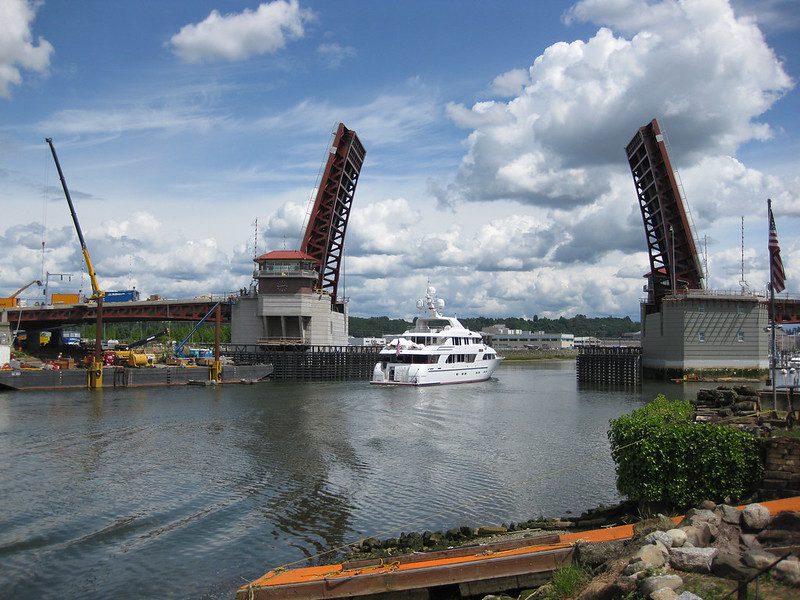 The Spokane St Swing Bridge (West Seattle Low Bridge) is a movable bridge across the Duwamish Waterway. Photo: SDOT
The Spokane St Swing Bridge (West Seattle Low Bridge) is a movable bridge across the Duwamish Waterway. Photo: SDOT At SDOT, it’s a core responsibility to provide safe, equitable, and accessible travel options that meet the needs of both current and future generations. We take this public duty very seriously!
We own and maintain a wide range of essential transportation infrastructure. In this blog post, we’re focusing on how we keep our drawbridges operating safely and efficiently. Our crews run regular tests, conduct routine safety checks, and complete proactive maintenance work to ensure that these important structures and transportation routes continue to operate safely and last as long as possible. This saves us—and taxpayers—more money in the long run and helps maximize our existing investments. Learn more about how we’re investing in, maintaining, and preserving our assets.
For example, our Roadway Structures team works year-round to extend the life of Seattle’s iconic drawbridges.
SDOT operates and maintains five of Seattle’s seven drawbridges: Ballard Bridge, Fremont Bridge, University Bridge, Spokane St Swing Bridge (also known as West Seattle Low Bridge), and South Park Bridge. The other two drawbridges, Montlake Bridge and 1st Ave S Bridge, are operated by the Washington State Department of Transportation (WSDOT). Thanks to frequent tests and maintenance, the Ballard, Fremont, and University bridges have been in use for over 100 years!
How old are the drawbridges that the City of Seattle operates ?
Ballard Bridge – built 1917
Fremont Bridge – built 1917
University Bridge – built 1919
Spokane St Swing Bridge – built 1991
South Park Bridge – rebuilt 2014
Our mechanical and electrical teams run tests each month on our drawbridges and perform balance checks when weight (like paint or additional parts) is added or removed from the bridges. Crews conduct more thorough routine inspections of each bridge in accordance with federal regulations. This way we can find any issues quickly, which helps prevent bigger and more costly repairs later. The team is also on call 24/7 with an electrician, mechanic, engineer, and supervisor ready to assist in case of an emergency.
In addition to inspections and proactive maintenance, we’re always thinking of new and innovative ways to better preserve our bridges so that they can operate further into the future.
For example, because of climate change, summer heat waves are now much more common than when our steel drawbridges were built 100 years ago. This created a new problem, because high temperatures can cause the metal in the drawbridge’s moving parts to expand and get stuck. A few years ago, we identified a solution to help with this problem, and now when temperatures get above 85°F, crews spray down the bridges to cool them to reduce the risk that they will get stuck.

Budget spotlight: The Mayor’s 2022 Proposed Budget includes $6 million to replace and upgrade mechanical and electrical components of the University, Ballard, and Spokane St bridges. Learn more.
The Spokane St Swing Bridge (also known as the West Seattle Low Bridge) is a special type of drawbridge in Seattle. When we need to open the bridge for ships on the Duwamish Waterway, the bridge’s two main concrete sides (also called spans) rotate 45 degrees sideways to open instead of raising into the air. Each bridge span “floats” on a steel barrel (called a cylinder) in hydraulic oil located on the center bridge piers. This allows for a smooth opening and closing each time.

We’re proactively taking measures to preserve the Spokane St Swing Bridge through a series of improvement projects. The bridge, which is located right next to the West Seattle High-Rise Bridge, is an essential route for emergency vehicles, transit, heavy freight, and people biking and walking while we’re working to repair the high bridge. Because the Spokane St Swing Bridge now plays such an outsized role as the link between West Seattle and the rest of the city, we’ve been taking additional steps to monitor and care for the bridge.
Beyond drawbridge maintenance, we’re also taking steps to better prepare our bridges for future earthquakes.
The SDOT bridge seismic retrofit program is another type of investment which goes above and beyond basic maintenance to bring sturdy but older bridges up to modern seismic standards. These upgrades work in tandem with the basic bridge maintenance, regular inspections, monitoring, preservation, and repairs we perform continually to keep bridges safe.
We have completed over 30 of these earthquake safety projects since 1990, and plan to complete earthquake safety upgrades on nine more bridges by the end of 2024 thanks to the voter-approved Levy to Move Seattle.




